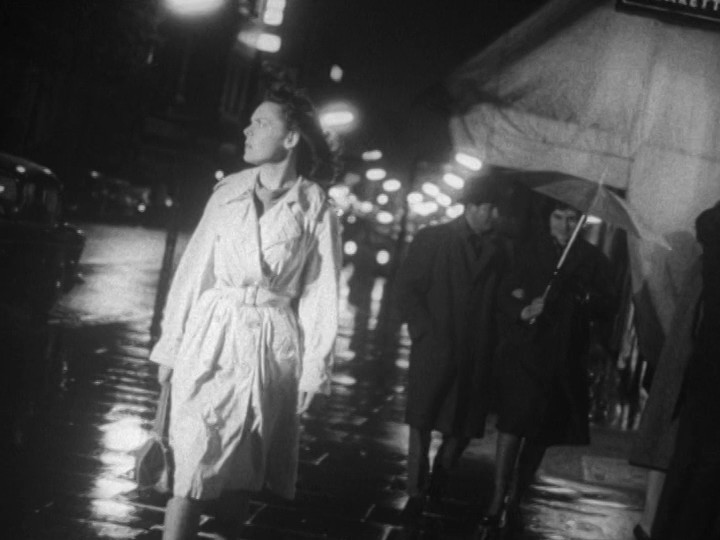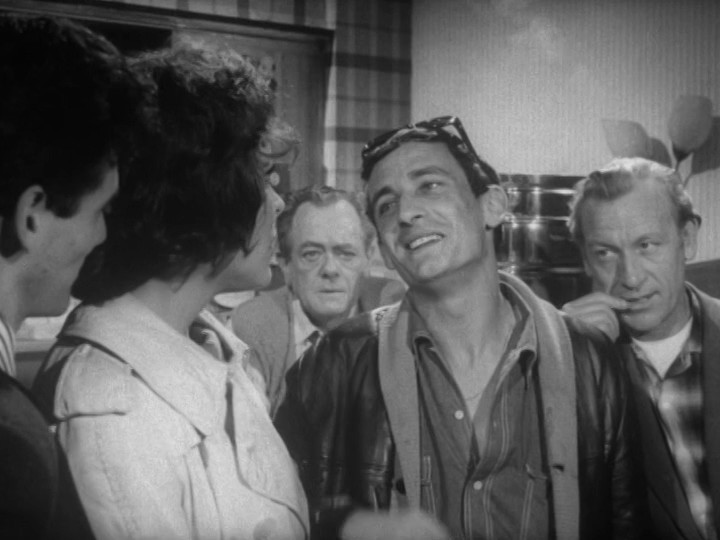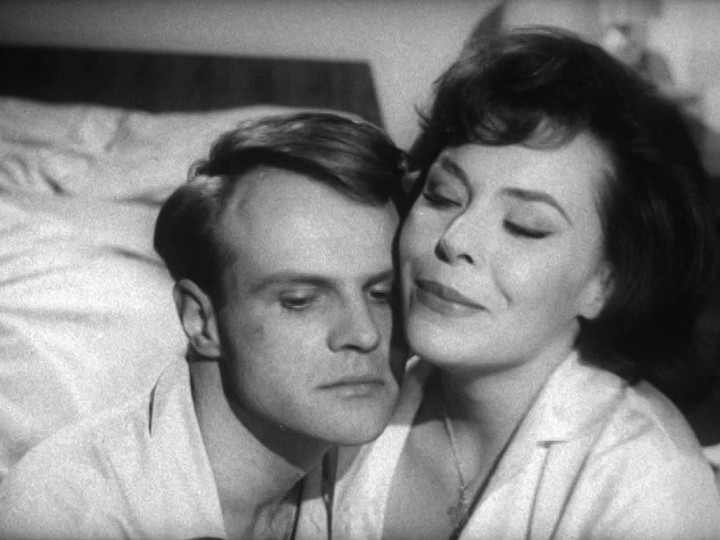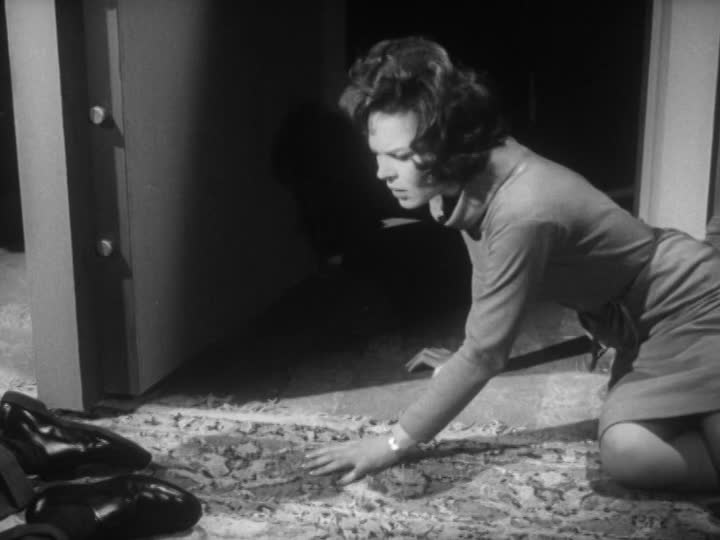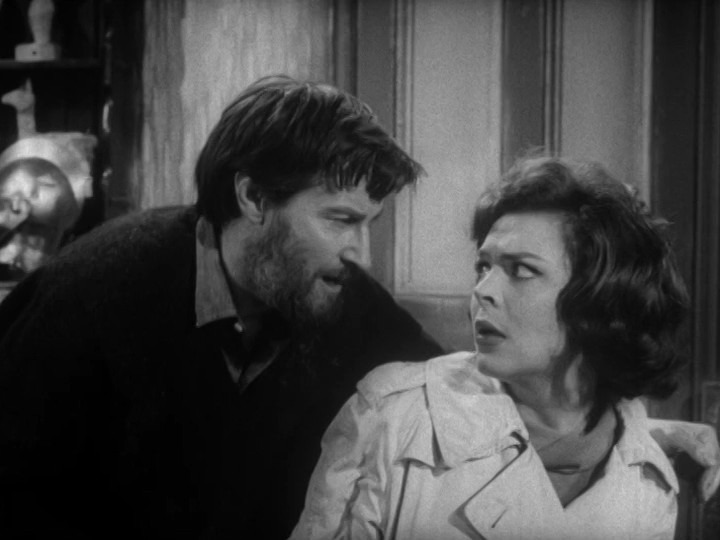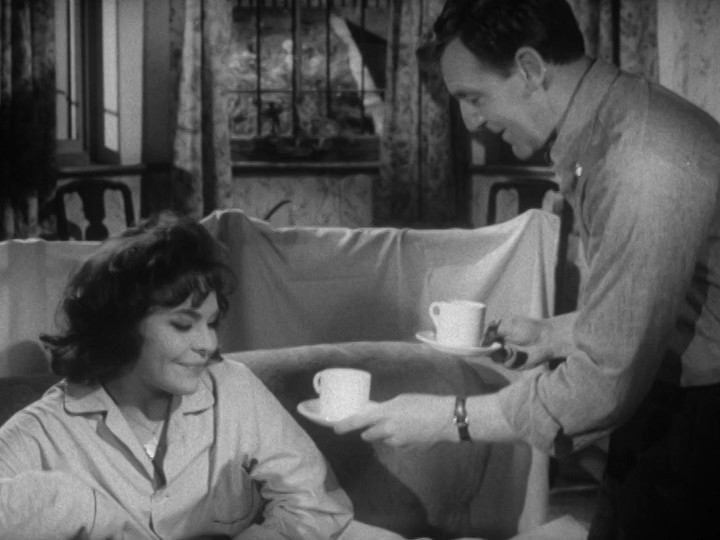The makers of Panic (1963, UK) were so certain of their best scene that they stuck a bit of it up front, before and during the opening credits: Janine (Janine Gray) running frightened through the night streets. Eight shots, as yet detached from any narrative purpose or context: traffic lights blinking, neon signs for a cabaret, a looming policeman, strangers streaming all around–and mostly Janine lurching back and forth, lunging into the foreground or fleeing into the background of the frame.
It is around fifteen minutes before these images return within the flow of the plot. Now the shot number has grown to twenty-five, covering ninety seconds, and the images expand in their variety–to include, notably, a smiling Asian gentleman (his entrance announced by a gong on the soundtrack!) whose pleasant candor scares the bejeezus out of Janine. Writer-director John Gilling works a set of small, stylistic variations with the skill and verve that George Miller brought to the first, equally low-budget Mad Max (1979): in the build-up of the first two shots of the sequence (Janine nervously passing a policeman) he uses matching, titled angles; as the tension builds, what sounds like racing cars fill the soundtrack with sudden accelerations, swerves and braking–this atop the soundscape of bells, horns and (eventually) a jazz trumpet score; and there is a generous scale of views of Janine near and far, in extreme-close-up or as a mere figure in the streetscape. . .always, of course, clutching her purse.
The more you study this neat little scene, you realize that Gilling is doing exactly the same thing Charles Laughton was praised for in the justly famous “floating down the river” sequence in The Night of the Hunter (1955): a perfect mix of real locations (out on the street) and studio work. Gilling merrily cuts back and forth between the realism of the exterior shots and entirely abstract arrangements of bodies and a few select props (such as a traffic light) in pure darkness. This mixture is not, as the professionals like to say, “seamless”; in fact, like Laughton, Gilling appears to delight in showing the seams, as these different textures clash and meld. The overall effect is lyrical, poetic, dreamlike.
But this is no Jean Cocteau film. Like much British genre cinema of the early 1960s—a field far more appreciated now than it was at the time by critics and connoisseurs—the atmosphere is mucky and amoral, saturated in cynicism, cheap thrills, and low-life gangsterism. A world away from both Hollywood film noir and the stylish gentlemen of Jean-Pierre Melville’s crime thrillers, Panic drops us into a disconcertingly mundane world of crooks who lounge about in low-rent offices, thugs who wear ties and delinquent dandies who cruise for a bruising in rock’n’roll cafes.
The network that can be drawn around Panic, backwards and forwards from it, is rich. There are evident traces of the American influence of Alfred Hitchcock’s Psycho (1960) and Orson Welles’s Touch of Evil (1958)–both considered, in their day, instances of once-great directors slumming it in disreputable TV and/or B-movie formats. But, closer to home turf, there are even clearer inputs coming from Michael Powell’s Peeping Tom (1960—another once-great contaminated by sensationalism), the films made in Britain in the 1950s and early sixties by Joseph Losey (his These are the Damned, released the same year as Panic, provides a close comparison) , and the career of Wolf Rilla, including his chilling Village of the Damned (1960). Further up ahead on this road is the more extreme surrealism of the Cammell/Roeg Performance (1970), and even the suburban section of Kubrick’s A Clockwork Orange (1971). And this is only the tip of a British iceberg that has been expertly circumnavigated by scholars including Robert Murphy (Sixties British Cinema, 2008) and Raymond Durgnat (A Mirror for England, first published in 1970 but re-released in a new, corrected edition by the BFI in 2011). In time, this entire style/sensibility nexus would slide over to UK television; but its glory years in sixties cinema have, particularly in retrospect, acquired an alluring aura.
How did Janine get into that frenzied, dreamlike state, stranded between street and studio? After its teaser prologue, the film proper begins—incongruously, in terms of how the rest of the storytelling will be structured–with Janine narrating how she first met the louche Johnnie (Dyson Lovell) “at a beatnik party.” That blasting jazz trumpet we often hear on the soundtrack is associated directly with him: he even practices it in bed, in his pajamas. This first glimpse of what was once quaintly called a “pre-marital” relationship is reminiscent of the opening, afternoon-delight tryst between Janet Leigh and John Gavin in Psycho: it’s all rumpled sheets and peeks of black underwear between bedroom, bathroom and kitchen—as well as intimations of a violent, anti-social streak in Johnnie, who expresses, in a kind of daze, would he would do to any “other man” who gets between them: “I’d kill him and I’d kill you, too”.
An intriguing dialogue couplet poses Johnnie’s ever-present libido—“Don’t you ever get carried away?”—with a hint of Janine’s own dissatisfactions: “Don’t you ever notice?” (This could be spoken between the Man and Woman in Bruno Dumont’s Twentynine Palms [2003].) In Gilling’s fluid mise en scène, Janine spends more time relating to mirrors than looking directly at her guy—yet another way of signaling (after the prologue and voice-over) that she, and not he, will be the central figure of the story—as she tries to talk him out of his crazy “get-rich-quick schemes.” But—in this historic moment when modern conceptions of love are stuck awkwardly between old-fashioned and new-fangled ways—it’s the man who nostalgically insists on getting married, while the woman resists, demanding a relationship on her “own terms.” Having uttered this, she promptly exits to spend the night at her own pad, for some much-needed alone-time.
What’s a struggling muso to do in a fix like this, except turn to petty, or even not so petty, crime? Johnnie’s get-rich plan is incorrigible: with two insalubrious pals who hang out in the cluttered office of an auto-parts shop, Tom (Stanley Meadows) and Ben (Brian Weske)—the latter has the kind of manic, high-pitched, machine-gun giggle familiar from psychopaths in Don Siegel films—he hopes to steal from Janine’s own workplace. The detail of the scheme are charmingly homely: Johnnie has nicked a letter that Janine brought home from work, allowing Tom and Ben to pretend to be German businessman (“Herr Schmidt and Herr Grueber”) and execute a robbery on the premises after-hours. The first sign that something is going to go wrong even with this simple set-up is Tom’s announcement, to Johnnie’s chagrin, that the latter’s unbeloved brother, Louis (Charles Houston), is also part of it, as the “fence.” And then there’s Janine herself, not in on the plan, whom Ben suspects will unravel the gig—because, after all, she’s a woman, and “every woman talks.. Johnnie quashes that doubt with his show-stopping reflection on Janine’s devotion to him: “If I poisoned her mother, she’d still protect me”.
Panic moves briskly. Its real centre of interest is less the office-vault heist itself (this is not a tricky crime film in the vein of the original The Italian Job [1969]) than the condition in which it leaves Janine: dazed and thoroughly confused. Tom & Ben as Schmidt & Grueber are after only one, valuable diamond; their path to it is delayed by old Jessop (Philip Ray), Head of the firm, prattling on about British coffee (“needs improvement”) and his trip to Berlin in 1951. In a quick flurry of action, Jessop is killed as he lunges for the alarm, and Janine is knocked out. Here is where the film really begins, twelve and a half minutes in.
It is puzzling at first to watch Janine, once she wakes, floating like a zombie through this crime scene (with only a ticking clock for aural accompaniment), robotically collecting her things, clasping her purse, and blankly exiting out the front door—rather than phoning or screaming for police assistance at the sight of her employer’s corpse. What the heck is she doing? Gilling had the difficult task here of conveying what is hard to make immediately evident: that this character has lost, temporarily or not, a part of her mind. In a “semantic drift” that Durgnat would doubtless have appreciated, the relationship uncertainties of a Modern Woman are, in this lightning transformation of the plot, unfussily translated into literal uncertainty over personal identity: Janine has not the slightest clue who she is or where she came from. Which includes, naturally, a lingering doubt as to her own guilt or innocence, implication or lack of it, in the grizzly crime.
There is a Jacques Tourneur quality–his London-set Curse of the Demon (a.k.a. Night of the Demon, 1957) comes to mind–in the succession of scenes that follow. The daily world is now “made strange” for Janine, and Gilling seizes the opportunity to defamiliarize it for us, as well—a perfect example of what Durgnat once dubbed the poetry of pulp. Once through the looking glass, Janine quickly experiences the world as a nightmarish jungle of beastly, menacing men, as Clarice Starling does in The Silence of the Lambs (1991): first Lantern (Marne Maitland) who rents her a room; then the large, bald, pock-faced chap who enters to warn her about Lantern; and eventually Johnnie’s no-good brother Louis (although she is as yet unaware of the connection, following only the letter she finds in her bag that she previously intended posting to him)—a cad who, as Tom mentioned earlier, has been led astray by his life-changing encounters with “a paint palette and a bottle of scotch.” Beware: an artist!
There is a lot of agony in the world of academic film studies these days about mending the perceived rift between text and context—closely attending to the details of a work without losing sight of the larger, framing, social world that gave rise to it in the first place; while also ensuring that the outside does not completely overwhelm the inside, that we do not just turn the film into an illustration of issues (or “tissues for issues,” as the Australian composer David Chesworth once put it). Watching a film like Panic is good for displacing this kind of badly posed, binary opposition of text and context: it cannot help but be some kind of “mirror for England,” intentionally or (more likely) not, in whatever distorted, mangled or semi-conscious way it processes a diversity of social inputs. This amounts to what commentators such as Tom O’Regan call the social text of a national cinema’s products.
Questions of nationality, for example, are nowhere near the thematic centre of Panic, but are everywhere floating on the surface. I have mentioned that Asian extra who makes a memorable appearance during Janine’s flight: the horror! There is also a thread of patter about partners in global business, such as the Germans. The casting itself is intriguing on this level: the fictional Janine Heining is meant to be Swiss (hence her proficiency in German), but the real Janine Gray was born, of British descent, in India: the film makes much of her aura of national/cultural foreignness and strangeness, her height (tall), accent, and burning, intense, slightly mad gaze. “I’m harboring a criminal,” murmurs the lascivious Lantern. “A foreign criminal, at that.” Gilling loves to film Gray (who later became a popular TV actor in series including The Saint and The Avengers) entering and exiting the frame on a stark diagonal line: she is a monument, both alluring and unsettling. Indeed, all the characteristic obsessions of 1960s British cinema—youth gone wild, the criminal underclass, the place of the artist, changing roles for men and women, the difficult place of sexual license in a generally repressed culture—are on display in the lively social text of Panic.
I have concentrated in this piece on the first half of Panic, which is its more outstanding part. Once an unambiguously good guy, Mike (Glyn Houston), enters the game of the plot, the poetry of pulp settles down somewhat, and the film finds a more conventional path to a possible resolution. But Gilling and his collaborators are, in the immortal phrase of Andrew Sarris, “subjects for further research.” Better known and remembered for films like The Flesh and the Fiends (1960) and The Reptile (1966), Gilling (who died in 1984) has yet to be much appreciated outside of his sterling contribution to the Hammer horror cycle. Panic’s producer and story-originator, Guido Coen (who died in 2010), enjoyed a long and colorful career, including such sensational stuff as Jungle Street Girls (1960) and Baby Love (1968). Sydney John Kay, composer of the splendid jazz score, was born Kurt Kaiser–a member of the famous German-Jewish band The Weintraub Syncopaters, who back up Marlene Dietrich on stage in The Blue Angel (1930). While various actors in Panic, particularly Janine Gray, went on to international careers in film and television, Dyson Lovell switched to producing for Franco Zeffirelli and Andrei Konchalovsky. And Stanley Meadows is fairly high up in the cast list of Performance—by which point, British cinema had evolved its reigning fantasies about criminality, loss of identity, and cultural “otherness” to an almost cosmic level.


